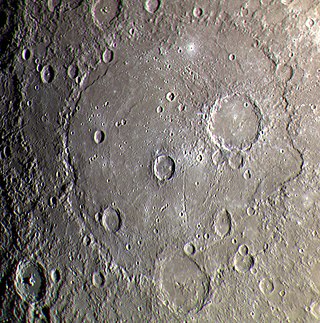Vostok refers to east in Russian but may also refer to:

Discovery Rupes is an escarpment on Mercury approximately 650 kilometers (400 mi) long and 2 kilometres (6,562 ft) high, located at latitude 56.3 S and longitude 38.3 W. It was formed by a thrust fault, thought to have occurred due to the shrinkage of the planet's core as it cooled over time. The scarp cuts through Rameau crater. It was discovered by Mariner 10.

Antoniadi Dorsum is a wrinkle ridge on Mercury at 25.1°N 30.5°W, approximately 359 km in length. In 1976, it was named by the International Astronomical Union after Eugène Michel Antoniadi.

Beethoven is a crater at latitude 20°S, longitude 124°W on Mercury. It is 630 km in diameter and was named after Ludwig van Beethoven. It is the eleventh largest named impact crater in the Solar System and the third largest on Mercury.

The Discovery quadrangle lies within the heavily cratered part of Mercury in a region roughly antipodal to the 1550-km-wide Caloris Basin. Like the rest of the heavily cratered part of the planet, the quadrangle contains a spectrum of craters and basins ranging in size from those at the limit of resolution of the best photographs to those as much as 350 km across, and ranging in degree of freshness from pristine to severely degraded. Interspersed with the craters and basins both in space and time are plains deposits that are probably of several different origins. Because of its small size and very early segregation into core and crust, Mercury has seemingly been a dead planet for a long time—possibly longer than the Moon. Its geologic history, therefore, records with considerable clarity some of the earliest and most violent events that took place in the inner Solar System.

Victoria Rupes is an escarpment in the Victoria quadrangle of Mercury. The quadrangle was named after this escarpment, and the escarpment itself was named after the Victoria, a ship used on the famous expedition of Ferdinand Magellan. Its name was adopted by the International Astronomical Union (IAU) in 1976.

Beagle Rupes is an escarpment on Mercury, one of the highest and longest yet seen. It was discovered in 2008 when MESSENGER made its first flyby of the planet. It has an arcuate shape and is about 600 kilometres (370 mi) long. The scarp is a surface manifestation of a thrust fault, which formed when the planet contracted as its interior cooled.

Sveinsdóttir is a large, elongated impact crater on Mercury. Its dimensions are 220 × 120 km.

Adventure Rupes is an escarpment on Mercury approximately 270 kilometres long located in the southern hemisphere of Mercury. Discovered by the Mariner 10 spacecraft in 1974, it was formed by a thrust fault, thought to have occurred due to the shrinkage of the planet's core as it cooled over time.

Resolution Rupes is an escarpment on Mercury approximately 190 kilometers long located in the southern hemisphere of Mercury. Discovered by the Mariner 10 spacecraft in 1974, it was formed by a thrust fault, thought to have occurred due to the shrinkage of the planet's core as it cooled over time.

Hero Rupes is an escarpment on Mercury more than 300 kilometres long located in the southern hemisphere of Mercury. Discovered by the Mariner 10 spacecraft in 1974, it was formed by a thrust fault, thought to have occurred due to the shrinkage of the planet's core as it cooled over time.

Vostok was a 28-gun sloop-of-war of the Imperial Russian Navy, the lead ship of the First Russian Antarctic Expedition in 1819–1821, during which Fabian Gottlieb von Bellingshausen and Mikhail Lazarev circumnavigated the globe, discovered the continent of Antarctica and twice circumnavigated it, and discovered a number of islands and archipelagos in the Southern Ocean and the Pacific.

Guido d'Arezzo is a crater on Mercury. It has a diameter of 58 kilometers. Its name was adopted by the International Astronomical Union (IAU) in 1976. Guido d'Arezzo is named for the Italian music theorist Guido of Arezzo, who lived from 990 to 1050.

Leopardi is a crater on Mercury. Its name was adopted by the International Astronomical Union in 1976. Leopardi is named for the Italian writer Giacomo Leopardi, who lived from 1798 to 1837.

Enterprise Rupes is an escarpment on Mercury, located at 36.54°S, 283.46°W. It is the longest rupes on Mercury, with a length of 820 kilometers (510 mi). The escarpment was named after USS Enterprise, a ship which conducted the first surveys of the Mississippi and Amazon rivers.

Belgica Rupes is an escarpment in the Debussy quadrangle of Mercury. The escarpment is approximately 425 km long and cuts across the crater Carleton. It was named after the RV Belgica, a Belgian ship used for an expedition to determine the position of the South Magnetic Pole in 1898, and the first ship to winter in Antarctica. Its name was adopted by the International Astronomical Union (IAU) in 2013.

Discovery Rupes is an escarpment on Mercury, approximately 267 kilometers (166 mi) long, located at latitude 58.52 N and longitude 53.25 W. It was formed by a thrust fault, thought to have occurred due to the shrinkage of the planet's core as it cooled over time. The scarp cuts through Duccio crater.

Enheduanna is a crater on Mercury. It has a diameter of 105 kilometers. Its name was suggested by Gagan Toor from India in a naming contest which was eventually adopted by the International Astronomical Union (IAU) on 2015. Enheduanna is named for the Sumerian poet Enheduanna. The craters Carolan, Kulthum, Karsh, and Rivera were also named as part of the contest.

Seuss is a crater on Mercury. Its name was adopted by the International Astronomical Union (IAU) in 2012. It is named for the American author and cartoonist Theodor Seuss Geisel, better known as Dr. Seuss.
















